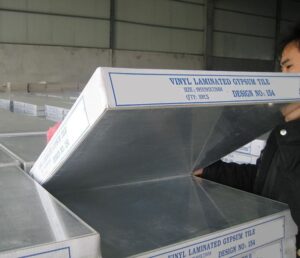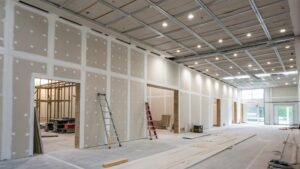A lot of people get confused when choosing a ceiling system. If you pick wrong, it can cost more money and slow down maintenance later.
A T-grid ceiling is a suspended ceiling system with a visible metal grid shaped like the letter "T", used to support removable ceiling tiles.

It is one of the most popular systems for offices, shops, and other commercial spaces. The grid holds panels, usually sized 2'x2' or 2'x4'. It allows easy access to the space above.
What are the three types of ceilings?
Many business owners ask me this when planning a renovation. If you choose by guesswork, you can end up with the wrong system for your needs.
The three main types of ceilings are suspended (grid) ceilings, direct-attach ceilings like drywall, and open ceilings with exposed structure and pipes.

When I explain this to clients, I break it down like this:
- Suspended ceilings hang from the building structure and can hide pipes, ducts, and cables. The T-grid ceiling is in this group.
- Direct-attach ceilings such as drywall fasten directly to the structure. They give a smooth, solid look but make above-space access harder.
- Open ceilings leave pipes, beams, and ducts visible. They are popular in industrial and modern-style spaces.
| Ceiling Type | Main Features | Common Uses | Access to Above Space |
|---|---|---|---|
| Suspended / Grid | Panels on a metal frame | Offices, retail, schools | Easy |
| Direct-Attach (Drywall) | Smooth surface | Homes, hotels, meeting rooms | Hard |
| Open | Exposed structure | Modern offices, lofts | Full |
In my work, I guide clients by asking about looks, maintenance needs, and budget. These three factors usually point to the right ceiling type.
How many types of grid ceilings are there?
Some think any grid ceiling looks the same. This is wrong. The design of the grid changes both style and function.
Grid ceilings come in various types such as standard T-grid, concealed grid, wide-span grid, seismic-resistant grid, and decorative grid systems.

Here is how I explain them in meetings:
- Standard T-grid is the basic visible frame system, simple and cost-friendly.
- Concealed grid hides most of the frame for a cleaner look.
- Wide-span grid covers large areas with fewer supports, often in big halls.
- Seismic-resistant grid is reinforced for earthquake zones.
- Decorative grid combines structure and design for visual appeal.
| Grid Type | Look / Style | Advantages | Typical Use Cases |
|---|---|---|---|
| Standard T-grid | Visible T-shapes | Low cost, easy install | Offices, retail |
| Concealed | Almost hidden frame | Clean look | High-end spaces |
| Wide-span | Large open bays | Fewer supports | Gyms, halls |
| Seismic-resistant | Strong reinforced | Safety in earthquakes | Hospitals, schools in seismic zones |
| Decorative | Custom shapes/color | Aesthetic choice | Hotels, restaurants |
I once suggested a seismic grid to a client in California. Later, an earthquake hit. Their ceiling stayed intact, and they were so glad they made that choice.
What is a T bar ceiling?
I hear this question often because “T bar ceiling” sounds like a different product. In truth, it is not.
A T bar ceiling is another name for a T-grid suspended ceiling. The "T bar" refers to the main and cross beams that hold the tiles.

The term comes from the shape of the cross-section of the beams. There is a main beam, secondary beams, and connectors that make the grid. Panels lay inside the grid openings.
In one office remodel I worked on, the client wanted flexibility to move lights and air vents. The T bar ceiling was perfect. We could lift a tile, shift wiring or ducting, and drop the tile back in place without cutting or repainting. That saved both time and money.
| Part of T-bar System | Role | Material |
|---|---|---|
| Main runners | Primary support beams | Galvanized steel |
| Cross tees | Secondary beams creating smaller grid cells | Galvanized steel |
| Wall angles | Support grid along perimeter | Aluminum or steel |
| Ceiling panels | Fill the grid openings | Mineral fiber, gypsum, or metal |
Conclusion
The T-grid, whether called T-bar or standard suspended ceiling, is a flexible, cost-friendly, and practical choice for many commercial spaces.



